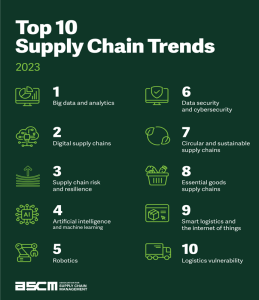There’s an inherent disconnect when discussing “health” when systemic crisis is the new norm. In 2022 supply chain woes were rampant–from port blockage, rising inflation, slowing demand, the war in Ukraine, COVID lockdowns, elevated inventory, hurricanes, and even MIA employees. Although there were improvements in some of these issues, disruptions to supply chain operations will continue in 2023 in the form of existing or new geopolitical conflicts, more inflation, recession, outrageous weather, and the re-emergence of COVID challenges.
A few significant challenges will undoubtedly be substantial investment into ensuring supply-chain health this year.

2023 Supply Chain Trends according to the ASCM
Cybercrime
Experts expect cybercrime to surge over the next few years, and supply chains will try to stay ahead of disaster. In 2023, cybercriminals will gain even more sophistication when tapping into supply-chain vulnerabilities, especially via the supplier network. Criminals continue to hack into IoT devices and, increasingly, into warehouse equipment such as barcode readers. Gartner predicts that by 2025, 45% of organizations globally will experience attacks on their software supply chains, a three-fold increase from 2021.
Geopolitical
Global political tensions are high, which will likely continue this year. Should this become even more acute, there will be an increased demand for greater domestic self-sufficiency to offset the possibilities that manufacturing, materials, and existing parts will be inaccessible and trade routes won’t remain open.
Which Shores?
During 2022, we saw the beginnings of onshoring efforts. During 2023, we’ll likely see increased interest in trade links and partnerships between friendly countries. Energy costs will drive friend shoring and nearshoring while efforts to accelerate more onshoring continue. However, these issues won’t be solved this year or even in the next few years.
Last-Mile Delivery
Getting finished goods out of the door and into the hands of consumers in 2023 will not be a walk in the proverbial park. Last-mile delivery challenges will require attention, and speed of delivery will remain a major consideration.
Sustainability
In 2023, regulators and important stakeholders will demand a focus on scope-3 emissions control. Suppliers are increasingly demanding the use of renewable raw materials. According to Accenture, supply chains generate 60% of carbon emissions, so manufacturing, emission tracking, and transportation changes will be critical to long-term sustainability.
Elusive Workers
There’s a massive labor shortage in every industry. The lack of available workers causes production to slow and, in some cases, stop completely, resulting in affected inventory levels, slowing the transport of goods between parties, and more. We continue to see supply chain leaders encouraged to revamp their hiring process, retention practices, compensation, and work/life balance environment. With the warehousing segment, however, it’s clear that robotics will pick up the worker slack. Even though education and investment are coming to the rescue to try to churn out workers—expect a slow recovery—and a “normal” that may never return.
Technology, Automation, and Digitalization
Companies will need to leverage their supply-chain data: effectively centralizing, accumulating, and analyzing the information. Investments in cloud-based digital transformation helps mitigate risks. Supply chain planning, greater automation of warehouse and operations, and better supply chain analytics to create enhanced visibility are on the 2023 drawing board. It’s adoption that needs to accelerate. Businesses know they need to invest and improve, but reality still often continues to lag need, and true supply-chain health will mean more significant action.

